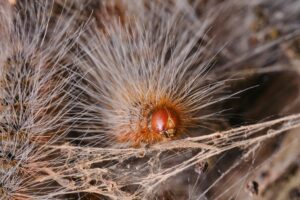AgriFutures Australia welcomes new Chairman
 THOROUGHBRED HORSES / Wednesday, 30 October 2024
THOROUGHBRED HORSES / Wednesday, 30 October 2024
Reminder: Keep an eye out for caterpillar eggs and nests during high-risk period

As we approach the high-risk period for exposure to hairy processionary caterpillars (Ochrogaster lunifer), it is crucial for stud staff to remain vigilant. These caterpillars, or their nest material, can cause significant harm to pregnant mares, leading to equine amnionitis and fetal loss syndrome (EAFL). This condition can result in mid- to late-term abortion or the birth of premature, weak, and underdeveloped foals.
Recommendations for stud staff:
- Exposure to hairy processionary caterpillars or their nest material can cause placentitis and abortion in pregnant mares.
- The highest risk period for pregnant mares is March–June when caterpillars are on the move. Manage the risks by removing egg masses during October–December and nests during January–March.
- Ensure to investigate all abortions with an extensive post-mortem, ultrasound other at-risk mares, and follow up with targeted veterinary treatment.
Understanding the risk
Mares are most at risk of exposure to caterpillars from March to June. During this time, caterpillars are on the move, and mares can encounter them in several ways:
- While grazing around trees where nests are present.
- Encountering head-to-tail processions as caterpillars move between trees.
- When mature caterpillars leave trees to pupate in pasture.
- If they disturb old nest material after caterpillars have left to pupate.
Horses can accidentally ingest microscopic, barbed caterpillar setae while grazing or feeding. These setae migrate through the gastrointestinal tract, carrying bacteria, and invade deeper tissues, including the uterus in pregnant mares. This can lead to severe infection, resulting in fetal death and abortion.
Caterpillar lifecycle
The moths that produce these caterpillars emerge from the ground in late spring (October to November). They mate, lay eggs in masses on native trees, and die. Caterpillars hatch from the eggs, feed on tree leaves at night, and return to the nest during the day. As they grow, the nest expands. When caterpillars eat all the foliage on a tree, they move in head-to-tail processions to another tree to build a new nest. By May to June, the caterpillars are mature and move into adjacent pasture to pupate, lying dormant until they hatch as moths in October to November.
Locate and eliminate
Removing pregnant mares from paddocks with caterpillar nests reduces the risk of EAFL, but this is often impractical due to the widespread distribution of nests. Finding and removing the nests is a more practical option. There are three nest types:
- Bag-type canopy nests: Leathery and dew-drop shaped, found high in eucalypt trees or wattles.
- Tree-hugger nests: Similar to canopy nests but attached to tree trunks at the base of a branch, found in Moreton Bay Ash trees (Corymbia tessellaris).
- Ground-based nests: Attach to the base of tree trunks, mainly in wattles (acacia species) and occasionally eucalypts.
Handle nest material with care
It is important to implement protocols for the safe handling of nest material and managing human exposure. Always wear personal protective equipment (PPE) when handling egg masses and nests, including disposable coveralls, gloves, eye protection, mask, and head cover.
Caterpillar nest material can cause severe itching and allergic reactions if it touches the skin. It can also cause severe irritation if it gets into the eyes, nose, or mouth. Individuals with asthma should be extra cautious. Nest material is light and easily dispersed by wind, so only remove nests during calm weather.
For disposal, deep burial is better than burning, as nest material can be dispersed by burning.
Prevention and early detection
While prevention is the ultimate goal, pregnancies can be protected if the condition is identified early and treated appropriately. Take these steps to protect your mares:
- Inspect tree trunks and branches for egg masses in October to December.
- Remove egg masses in October to December and caterpillar nests in January to March.
- Dispose of eggs and nests in a deep hole.
- Discuss the use of ultrasound examination and targeted treatment of mares in high-risk paddocks with your vet.
By staying vigilant and taking proactive measures, we can protect our mares and help prevent EAFL.
Find out more about caterpillar control to reduce EAFL risk
Learn more about AgriFutures research investments in equine diseases and parasites
Subscribe for more updates
This resource was produced as part of an AgriFutures Thoroughbred Horse Program project, utilising research outcomes from the University of Queensland (UQ). UQ’s research was supported by a UQ Collaboration and Industry Engagement Fund (CIEF) grant, the Hunter Valley Equine Research Foundation (HVERF), and an Australian Research Council (ARC) Linkage Project grant (LP140100687).
Latest News
-
AgriFutures Australia welcomes new Chairman CORPORATE / 30.10.24
CORPORATE / 30.10.24 -
Protecting Australia's beekeeping future through smart traceability HONEY BEE & POLLINATION / 30.10.24
HONEY BEE & POLLINATION / 30.10.24 -
Meet your future agronomists: The five Horizon Scholars getting a career head start WORKFORCE AND LEADERSHIP / 30.10.24
WORKFORCE AND LEADERSHIP / 30.10.24 -
New data reveals $8 billion contribution of Australia’s chicken meat industry CHICKEN MEAT / 30.10.24
CHICKEN MEAT / 30.10.24






